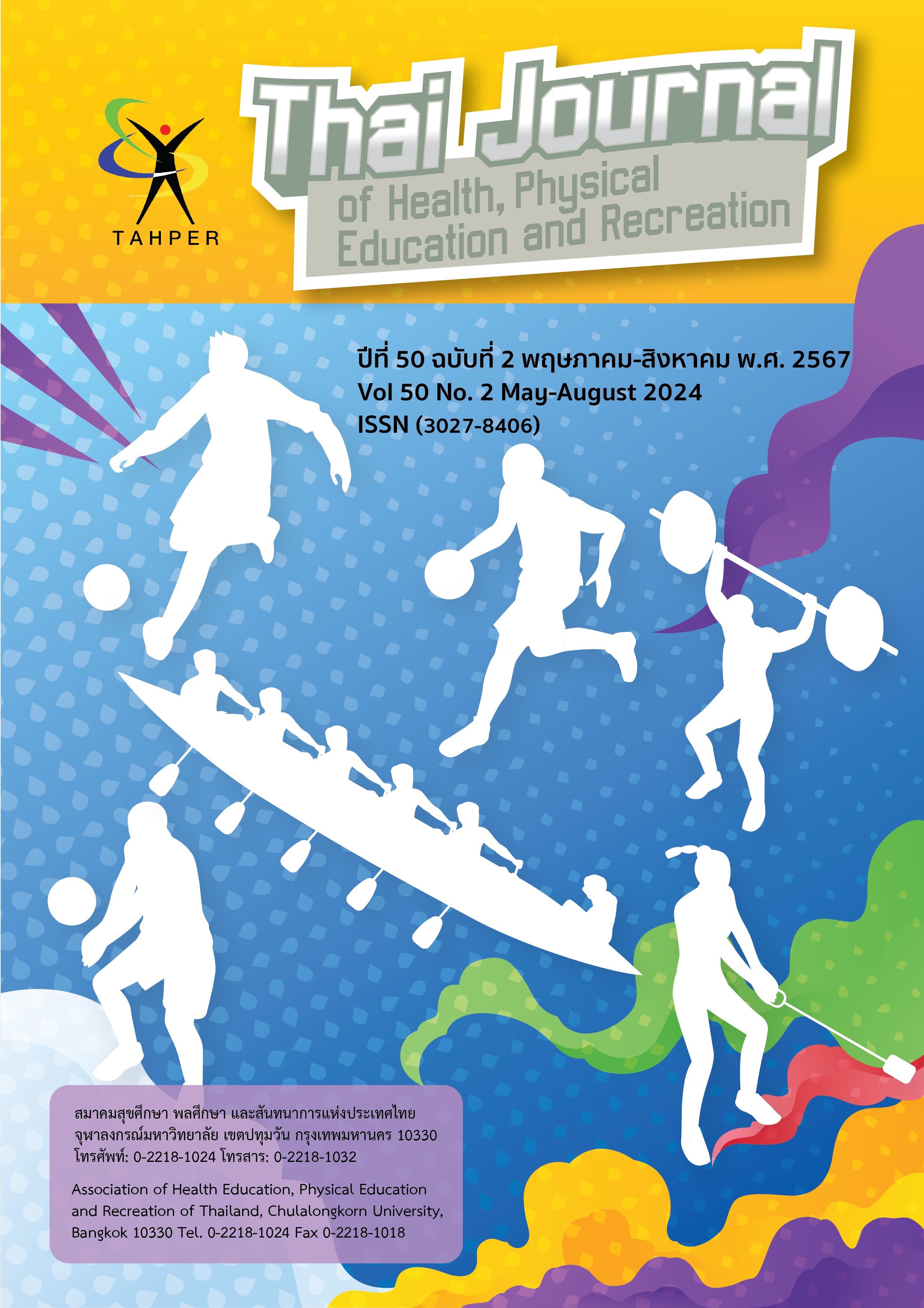The Effect of Organizing Movement and Rhythm Activities on the Social Behaviors for Early Childhood
Main Article Content
Abstract
The objective of this research is to examine the effects of organizing movement and rhythm activities on the social behaviors of preschool children. The target group consisted of boys and girls aged between 5-6 years, enrolled in the third year of kindergarten, first semester, academic year 2023, at Wat Khok Jala School, under the supervision of the Office of the Private Education Commission : OPEC), with a sample size of 16 children. The research tools utilized in this study included 12 movement and rhythm activity plans and observation forms for social behaviors
of preschool children. Quantitative data analysis was conducted using statistical measures such as mean, standard deviation, while qualitative data analysis involved content analysis and
qualitative description.
The research findings revealed that preschool children who participated in movement and rhythm activities exhibited higher overall and specific social behaviors scores post-activity compared to pre-activity levels. The highest average scores post-activity were observed in areas of assistance, sharing, cooperation, and adherence to agreements, respectively.
Article Details

This work is licensed under a Creative Commons Attribution-NonCommercial-NoDerivatives 4.0 International License.
Critical thinking in journals is the right of the author. The Association of Health Education, Physical Education and Recreation of Thailand is not always required, to create diversity in ideas and creativity.
ความคิด ข้อวิพากษ์ในวารสารเป้นสิทธิของผู้เขียน สมาคมสุขศึกษา พลศึกษา และสันทนาการแห่งประเทศไทยไม่จำเป็นต้องเห็นชอบด้วยเสมอไป เพื่อให้เกิดความหลากหลายในความคิดและความสร้างสรรค์
References
Bandura, A. (1977). Social learning theory: A social cognitive theory. New Jersey: Prentice – Hall.
Erikson Erik H. (1997). The Life Cycle Completed. New York: W. W. Norton.
Gesell, Arnold. (1964). F.L. The Child From Five to Ten. New York : Harpers and Brothers.
Krogh, S.L. and L.L. Lamme. (1983). Learning to Share : How Literature Can Help. Childhood Education. 59(3), 183-192.
Mussen, H., Conger, J.J., & Kagan, J. (1969). Child Development and Personality (3rd ed.).New York: Harper and Row.
Piaget, J. (1952). The origin of intelligence in children. New York: W.W. Norton.
กระทรวงศึกษาธิการ. (2560). หลักสูตรการศึกษาปฐมวัย สำหรับเด็กอายุ 3 – 6 ปี กรุงเทพฯ : สำนักวิชาการ และมาตรฐานการศึกษา สำนักงานคณะกรรมการศึกษาขั้นพื้นฐานกระทรวงศึกษาธิการ.
กระทรวงศึกษาธิการ. (2563). นโยบายและจุดเน้นการปฏิรูปการศึกษาปี งบประมาณ 2563. http://www.moe.go.th.
กระทรวงศึกษาธิการ. (2564). การพัฒนาเด็กอย่างเป็นองค์รวม. กรุงเทพฯ: พลัสเพรส.
ญาดา ช่อสูงเนิน. (2562). สร้างองค์ความรู้บนพื้นฐานคอนสตรัคติวิสต์. ศึกษาศาสตร์มหาบัณฑิต. สาขาการศึกษาปฐมวัย มหาวิทยาลัยศรีนครินทรวิโรฒ.
ตะวัน เทวอักษร. (2556). ทักษะการคิดพื้นฐานสำคัญในการพัฒนาการศึกษาไทย. การพัฒนาทักษะการคิด, 5(13), 4.
ภัสรา เอกมาตร. (2556). การจัดการชั้นเรียนตามทฤษฎีการเรียนรู้ทางสังคมของแบนดูราที่มีต่อพฤติกรรมทางสังคมของเด็กปฐมวัย โรงเรียนบ้านดงคำโพธิ์. การศึกษาค้นคว้าอิสระปริญญาศึกษาศาสตรมหาบัณฑิต, สาขาหลักสูตรและการสอน,มหาวิทยาลัยนอร์ทกรุงเทพ.
มณีรัตน์ ลีลา. (2563). การพัฒนาความสามารถในการใช้กล้ามเนื้อมัดใหญ่ของเด็กปฐมวัยระดับชั้นบ้านสาธิตโดยการจัดกิจกรรมเคลื่อนไหวและจังหวะ (รายงานการวิจัยปฏิบัติการในชั้นเรียน). กรุงเทพฯ: คณะครุศาสตร์ มหาวิทยาลัยสวนดุสิต.
สำนักงานเลขาธิการสภาการศึกษา. (2561) แนวแนะวิธีการเลี้ยงดู ดูแล และพัฒนาเด็กปฐมวัยตาม สมรรถนะ เพื่อเพิ่มคุณภาพเด็กตามวัย 0-5 ปี. กรุงเทพฯ: พริกหวานกราฟฟิค.


